An application of a distributed hydrological model to habitat evaluation
As a framework of IGBP (International Geosphere-Biosphere Programme) in ICSU, models to illustrate interaction between biospheres and hydrological processes strongly need to be structured. In addition, IPCC reported inevitable climatic changes obviously triggering hydrological transitions in the future. Not only the riverine hydrologic changes themselves but also anthropogenic alterations (e.g., reservoir construction) can influence on freshwater habitat environment.
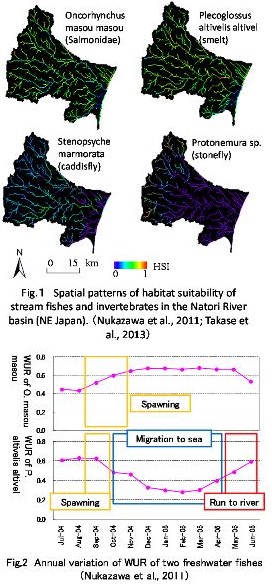 A habitat suitability modeling as a part of physical habitat simulation model (PHABSIM) is a conventional approach for biological assessments using hydrodynamic models. Habitat suitability models have the advantage of representing quantitative habitat quality for specific taxa based on ambient environmental heterogeneity. However, such habitat models do not consider spatiotemporally dynamic aspect of stream (e.g., seasonal variation of flow and temperature). Furthermore, developing habitat model including PHABSIM is generally time-consuming, interrupting comprehensive assessment (e.g., basin scale). To address the problem, an application of a distributed hydrological model to ecological scheme is a promising approach because the model enables us to simulate ecological patterns that hinge on hydrological regimes and reduce the costs of performing massive surveys and conducting experiments.
A habitat suitability modeling as a part of physical habitat simulation model (PHABSIM) is a conventional approach for biological assessments using hydrodynamic models. Habitat suitability models have the advantage of representing quantitative habitat quality for specific taxa based on ambient environmental heterogeneity. However, such habitat models do not consider spatiotemporally dynamic aspect of stream (e.g., seasonal variation of flow and temperature). Furthermore, developing habitat model including PHABSIM is generally time-consuming, interrupting comprehensive assessment (e.g., basin scale). To address the problem, an application of a distributed hydrological model to ecological scheme is a promising approach because the model enables us to simulate ecological patterns that hinge on hydrological regimes and reduce the costs of performing massive surveys and conducting experiments.
To evaluate habitat of aquatic animals (e.g., fishes and invertebrates), we modeled habitat suitability using a distributed runoff model coupled with a heat budget model (Kazama et al., 2007; Nukazawa et al., 2011), land cover data, and digital cartographic data. As a result, habitat suitability index (HSI) of Oncorhynchus masou masou and Plecoglossus altivelis altivel were disposed to be high in locations where they were actually observed, as well as caddisfly and stonefly species (Fig.1). Weighted usable rate (WUR); indicating proportion of suitable area in focal area, of P. altivelis altivel and O. masou masou dropped and elevated during winter and spring to summer (Fig.2), corresponding to seasonal behavior such as spawning and migration.
Nukazawa et al., Ecological Modelling, 2011
Takase et al., Proceedings of 2013 IAHR World Congress, 2013
An application of a distributed hydrological model to prediction of biodiversity
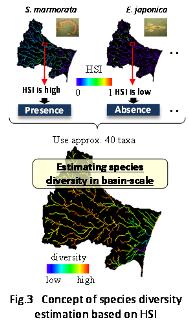 We also try to model two levels of biodiversity, species and genetic diversity, which are central concepts featured in the Convention on Biological Diversity (CBD).
Species and genetic diversity is defined as the number of species or as mathematical equation based on quantitative assemblage data and intra-specific genetic polymorphism detected through DNA fingerprinting technologies including amplified fragment length polymorphism (AFLP) and microsatellite analysis.
We also try to model two levels of biodiversity, species and genetic diversity, which are central concepts featured in the Convention on Biological Diversity (CBD).
Species and genetic diversity is defined as the number of species or as mathematical equation based on quantitative assemblage data and intra-specific genetic polymorphism detected through DNA fingerprinting technologies including amplified fragment length polymorphism (AFLP) and microsatellite analysis.
To date, most of studies exploring stream diversity are limited to snapshot investigation on scattered study sites since temporally successive field survey in broad region needs considerable cost and time.
Although researchers have founded many predicting models using hydrodynamic models in the PHABSIM/HSI framework, systematic model to predict species or genetic diversity has been rarely studied so far.
We developed a theoretical species diversity model based on habitat suitability index (HSI) of freshwater animals (Fig.3). The HSIs were developed using a distributed hydro-thermal model for around 40 aquatic taxa.
Estimated spatial pattern of species diversity (Fig.3) exhibited similar trend to observed species diversity of benthic animals.
This model can be applied to future projections of species diversity associated with exploitations (i.e., land-use changes) and hydrological regime transitions (i.e., climate changes).
Nukazawa et al., in revision
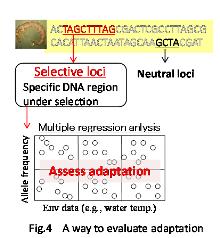 In the discipline of landscape genetics, a little is known how wild population shows adaptive behaviors to given heterogeneous environments. To understand adaptive genetic variation along hydrological gradient, we are trying to establish a novel framework based on loci subjected to selection and a distributed hydro-thermal model developed for a small basin in NE Japan. We employed multiple regression analysis to examine relationships between allele frequencies of local populations at selective loci and the simulated hydrological and thermal variables (Fig.4).
Of the four study species, a caddisfly species Stenopsyche marmorata provided a strong evidence of local adaptation to annual maximum water temperature at many loci. Assuming that the estimated regression models were applicable throughout the study area, we will be able to visualize the geographic distributions of local genetic diversity along the simulated hydro-thermal gradients.
In the discipline of landscape genetics, a little is known how wild population shows adaptive behaviors to given heterogeneous environments. To understand adaptive genetic variation along hydrological gradient, we are trying to establish a novel framework based on loci subjected to selection and a distributed hydro-thermal model developed for a small basin in NE Japan. We employed multiple regression analysis to examine relationships between allele frequencies of local populations at selective loci and the simulated hydrological and thermal variables (Fig.4).
Of the four study species, a caddisfly species Stenopsyche marmorata provided a strong evidence of local adaptation to annual maximum water temperature at many loci. Assuming that the estimated regression models were applicable throughout the study area, we will be able to visualize the geographic distributions of local genetic diversity along the simulated hydro-thermal gradients.
Nukazawa et al., Journal of Biogeography, 2015
Species and genetic diversity of invertebrates along a mountain stream fragmented by check dams
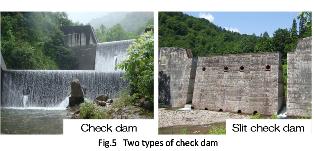 The unslit check dam (or sabo dam, Fig.5) stores sedimentation from the upstream and makes river gradient lower. As a result, the dam reduces impact of erosion, excessive sediment accumulation at reservoir located in the downstream, and landslides.
However, it also has some negative effects because the river stream is fragmented by an unslit check dam causing sedimentation level in the upstream reach becomes fairly homogenous, while river bed in the downstream reach is degradated. Up to today, although many concerns are on the impact of the reservoir dams to river ecosystems, impacts of check dams have not been well documented.
The unslit check dam (or sabo dam, Fig.5) stores sedimentation from the upstream and makes river gradient lower. As a result, the dam reduces impact of erosion, excessive sediment accumulation at reservoir located in the downstream, and landslides.
However, it also has some negative effects because the river stream is fragmented by an unslit check dam causing sedimentation level in the upstream reach becomes fairly homogenous, while river bed in the downstream reach is degradated. Up to today, although many concerns are on the impact of the reservoir dams to river ecosystems, impacts of check dams have not been well documented.
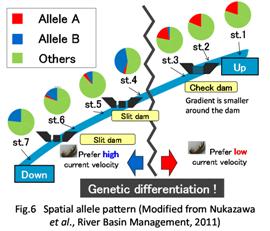 In order to assess the impacts of check dam, species diversity of benthic faunal communities and genetic diversity of caddisfly Stenopsyche marmorata were investigated using microsattellite analysis along Oisawa River, Japan. The Oisawa River is fragmented by two slit check dams and one unslit check dam. Over the slit dams, Shannon-Weiner diversity indices and number of taxa ranged from 0.90 to 1.02 and 13 to 15 respectively in the upstream region, and also from 0.98 to 1.18 and 13 to 20 respectively in the downstream region.
In order to assess the impacts of check dam, species diversity of benthic faunal communities and genetic diversity of caddisfly Stenopsyche marmorata were investigated using microsattellite analysis along Oisawa River, Japan. The Oisawa River is fragmented by two slit check dams and one unslit check dam. Over the slit dams, Shannon-Weiner diversity indices and number of taxa ranged from 0.90 to 1.02 and 13 to 15 respectively in the upstream region, and also from 0.98 to 1.18 and 13 to 20 respectively in the downstream region.
Through microsatellite analysis of S. marmorata, we found two selective alleles, which shows clear genetic differentiation among three upstream sites and four downstream sites in the study area. Differences of community’s species compositions between sites were correlated to geographical distances whereas genetic distances between sites were not correlated to geographical distances, suggesting that species compositions of the communities were determined through the process of species adaptation to the local environment.
We concluded that increments of species diversity at the inlet reaches of the slit dam were caused by the recovery of habitats, and by the continuousness of stream which allows the flowing of particulate organic matters and sediments to the downstream. We found a possible evidence of a genetic selection to the different extent of velocity triggered by check dam constructions (see two types of alleles in Fig.6) because S marmorata (filter-feeder) constructs nets to filter and collect fine particulate organic matters (FPOM) from water flow.
Nukazawa et al., Proceedings of 5th APHW Conference, 2010
Nukazawa et al., WIT Transactions on Ecology and the Environment, 2011
Gakuen Kibanadai-nishi 1-1, Miyazaki, 889-2192 JAPAN.
Department of Civil and Environmental Engineering, University of Miyazaki
Tel: +81-985-58-7334
E-mail: nukazawa.kei.b3[at]cc.miyazaki-u.ac.jp
(change [at] to @)